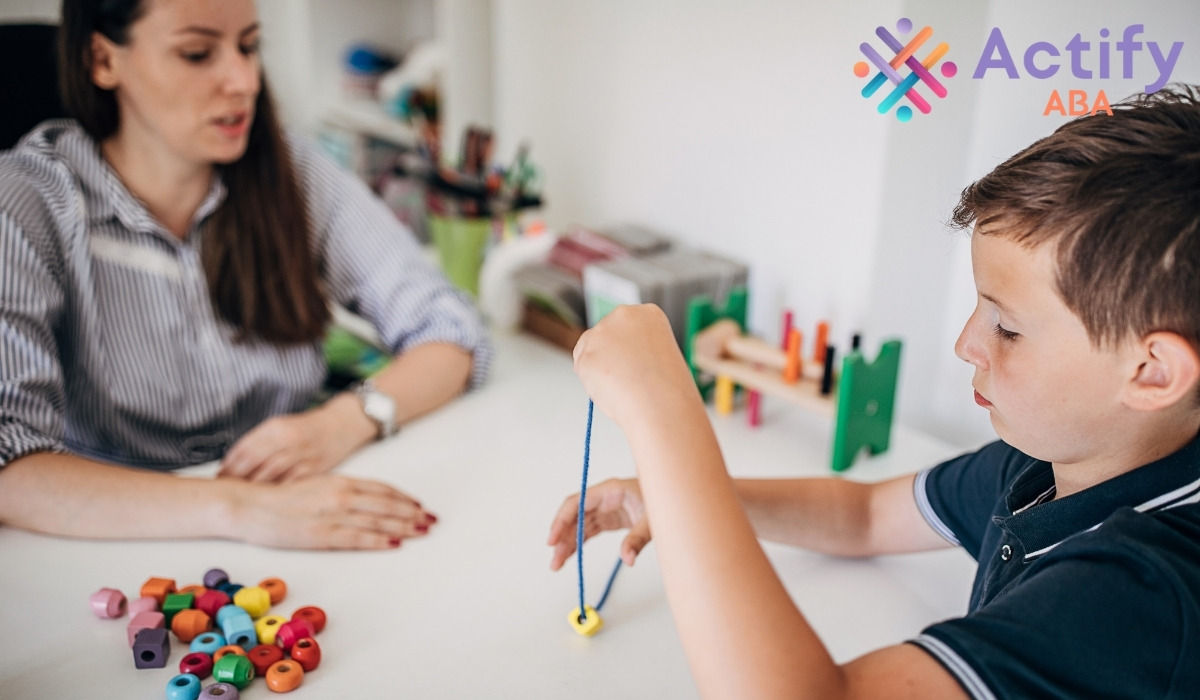
Key Points:
- Behavior modification in ABA focuses on reinforcing desired behaviors and reducing challenging ones through structured strategies.
- Using chaining techniques helps children learn complex tasks by breaking them into manageable steps.
- Understanding an ABA chaining example helps parents and caregivers support skill-building in daily routines.
Behavior modification, a core principle of Applied Behavior Analysis (ABA), plays a critical role in helping children with autism develop independence. According to research, approximately 40% of children with autism have an intellectual disability, which often makes learning multi-step tasks especially challenging. This is where ABA techniques like chaining come into play, breaking complex skills into smaller, teachable steps.
In this guide, we’ll explore how behavior modification and ABA therapy work together to build essential life skills. You’ll learn how chaining works, when it’s used, and how it empowers children to succeed with confidence. Parents and caregivers will also find practical strategies for supporting skill-building at home.
What is Chaining in ABA?
A chaining in ABA shows how a complex behavior is taught by breaking it into individual steps, each reinforced as the child progresses through the task. There are three main types: forward chaining, backward chaining, and total task presentation.
Let’s say a child is learning to wash their hands. In backward chaining, the adult helps with all steps except the last, allowing the child to complete the final action (e.g., drying hands) and receive praise. As they master that step, earlier steps are gradually handed over to them. This method increases success, builds confidence, and ensures the task is learned systematically.
How Does Behavior Modification Work in ABA Therapy?
Behavior modification in ABA therapy is rooted in reinforcement. The goal is to increase helpful behaviors—like following instructions or completing tasks—and decrease behaviors that interfere with learning or social participation.
At its core, behavior modification uses four main tools:
Positive Reinforcement
Adds something desirable—like praise or a reward—to increase the likelihood of a behavior happening again.
Negative Reinforcement
Removes something unpleasant—like a loud noise or difficult task—to encourage a desired behavior.
Extinction
Eliminates the reinforcement maintaining a problem behavior, helping it gradually decrease over time.
Prompting and Fading
Provides support to guide behavior initially, then reduces that help as the child becomes more independent.
Behavior change is never about punishment. Instead, it’s about teaching new, useful ways of acting and responding to the world.

What is the Role of Chaining in Behavior Modification?
Chaining in behavior modification helps children learn complex tasks by breaking them into smaller, manageable steps. Each step is taught sequentially, allowing the child to build confidence and master one part of the task at a time. This structured approach makes learning less overwhelming and more achievable.
By reinforcing success at each step, chaining promotes independence and helps children with autism generalize skills across settings. It’s a powerful method for building consistent, long-term behavior change.
What are the Different Types of Chaining in ABA?
In ABA therapy, chaining is especially helpful for teaching life skills like brushing teeth, dressing, or preparing food. There are three common chaining procedures. Each has a different starting point and is selected based on what works best for the learner.
Here are the different types of chaining in ABA:
1. Forward Chaining
In this method, teaching begins with the first step of the task. The child completes step one independently, and the adult assists with the rest. As step one is mastered, step two is added, and so on.
Example: Tying shoes
- Step 1: Pick up the laces (child does this)
- Step 2: Cross the laces (adult helps)
- Step 3: Make loops, tie bow, etc. (adult helps)
2. Backward Chaining
This starts with the last step of the task. The adult performs all steps up to the last one, which the child completes. Gradually, earlier steps are introduced.
Example: Putting on a shirt
- Steps 1–3: Lifting arms, pulling over head (adult helps)
- Step 4: Pulling shirt down (child does this independently)
3. Total Task Presentation
The child is prompted to complete the entire task from the beginning, receiving assistance only where needed. This works well for learners who can handle longer routines with minimal support.
Example: Setting the table
- Child attempts each step: placing plates, utensils, and napkins
- The therapist or parent provides prompts only when necessary
Each of these methods can be adjusted based on how the child responds and what kind of reinforcement motivates them.
What Skills Can Be Taught Using ABA Chaining?
Chaining can be applied to countless daily routines, social tasks, and academic behaviors. When used alongside reinforcement, it helps children master long tasks without becoming discouraged.
Here are skill areas commonly taught using chaining:
1. Self-Care Skills
Chaining helps children learn multi-step personal routines like brushing teeth, toileting, dressing, and washing hands by teaching each step one at a time with guided support and reinforcement.
2. Household Tasks
Daily tasks such as cleaning up toys, making simple meals, or setting the table are broken into manageable steps to promote independence and responsibility through consistent practice and support.
3. School Skills
Academic routines like packing a backpack, completing worksheets, and following classroom procedures become more achievable when taught in sequence using chaining strategies tailored to the child’s learning style.
4. Social Sequences
Chaining supports social development by teaching structured interactions like greeting others, turn-taking, or asking for help, helping children build confidence in peer and adult communication.
The beauty of chaining is that it meets learners where they are and builds up, step by step.
What Makes ABA Chaining Effective for Children with Autism?
ABA chaining is effective for children with autism because it breaks complex tasks into manageable, sequential steps, reducing overwhelm and promoting success. This structure supports children who struggle with executive functioning, attention, or multi-step directions.
By focusing on one step at a time and using consistent reinforcement, chaining builds confidence, fosters independence, and improves the likelihood of generalizing skills across settings. Its flexibility allows therapists to tailor teaching methods to each child’s strengths and learning pace.
What Should Parents Know About Behavior Modification and ABA?
Parents don’t need to be behavior analysts to support their child’s progress, but understanding basic ABA strategies, like chaining, can be empowering. Behavior modification starts at home and thrives when parents are consistent, patient, and involved.
Here’s how parents can support the process:
1. Ask Your BCBA About Chaining
Speak with your child’s BCBA to understand which skills are being taught through chaining and how you can reinforce them at home. Clear communication ensures consistency between therapy sessions and daily routines.
2. Practice at Home
Use the same prompts, cues, and task steps from therapy during everyday activities. Repetition in natural settings helps children retain skills and become more confident in their ability to complete tasks independently.
3. Celebrate Small Wins
Acknowledge and praise even the smallest progress, like completing one step of a task without help. Encouragement boosts motivation and reinforces the child’s sense of accomplishment and confidence.
4. Track Progress
Use simple tools like charts, stickers, or checklists to track which steps your child can do on their own. Monitoring helps identify growth areas and reinforces positive patterns over time.
5. Be Patient and Stay Consistent
Learning takes time, especially for complex or multi-step tasks. Remain calm, offer support, and celebrate progress without rushing the process. Consistency and patience lead to meaningful, lasting behavior change.

When Should Chaining Be Used Instead of Other Teaching Methods?
Chaining should be used when a task is made up of multiple, clearly defined steps that need to be performed in a specific order, like brushing teeth, tying shoes, or setting the table. For children who struggle with executive functioning, memory, or attention, breaking down complex behaviors into manageable components can reduce overwhelm and improve learning.
Compared to other teaching strategies like modeling or discrete trial training, chaining provides a sequential roadmap that builds success gradually. It’s particularly helpful when a child frequently stops mid-task or appears confused about what comes next.
If the goal is to promote independence with daily living skills or multi-step academic routines, chaining is often more effective than trying to teach all steps at once or relying solely on imitation.
Take the First Step Toward Positive Change With ABA Therapy
From brushing teeth to preparing meals, every skill your child learns is a step toward greater independence. Behavior modification techniques like chaining help break big goals into small, achievable steps—and provide the structure children with autism often need to thrive.
At Actify, we provide personalized, evidence-based ABA therapy in Maryland that supports children and families at every stage. Our team uses tools like chaining, reinforcement, and parent training to create lasting change that extends beyond the therapy room.
Get in touch with us to learn how ABA therapy in Maryland can help your child develop real-life skills and build confidence, one success at a time.
